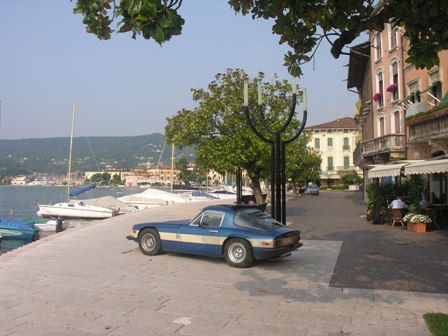
This was to have been a report of the ORCA rally through Italy, Switzerland, France and Monaco but unfortunately that was another casualty of the Greek financial crisis. In the end there were only 6 entrants and the organisers decided to cancel. We had been looking forward to the event for some time, so we decided to arrange our own trip. To comply with my insurance policy and Greek licensing regulations I needed to be using the car for a classic rally or old car shows. A few emails to friends resulted in an invitation to join the Italian TVR club on an informal weekend run in the area around Parma. After a few days on the computer we had booked ferries and hotels and worked out a tour for the weeks either side of the event. Valerio, the President of the TVR club issued me with a very impressive entrant’s registration certificate to take to my insurers who didn’t even query why I needed a Green Card for a fortnight to get to a two day event.
Tuesday 22nd June we drove from Athens to Patras and caught the ferry to Ancona. We arrived in Italy at about 3:00 pm on the Wednesday and drove straight to our first hotel at Campestri in the heart of Tuscany. The hotel was a lovely old villa set in many acres of well cared for olive orchards. Although we were only 10 miles or so from Florence we decided to spend the next few days touring the beautiful countryside. Neither of us had been to Tuscany before and we were surprised to discover how mountainous the “green hills of Tuscany” are.
On the afternoon of Friday 25th June we drove to Salsomaggiorore Terme near Parma in Piacenza. Our hotel there turned out to be another lovely old building on a hillside on the outskirts of the town. Salsomaggiore is situated in a valley with natural salt deposits and has been the site of many battles for possession of that once valuable commodity. More recently the therapeutic properties of some of the natural sulphuric springs have been exploited and the town possesses several very fine spa buildings in the Italian “Liberty” style of the turn of the 20th century. Many of the castles that surround this area, which we were to see during the Italian TVR club run, were built to defend the salt rights of the noble families.
The club run started at midday at a village called Varano de Melagari on the Saturday, near the famous Varano race circuit. We met in the car park of Dallara Automobilla, the manufacturer of the Formula 3 chassis that have dominated the class for as long as I can remember. We had hoped for a brief tour but some important development work resulted in our factory visit being cancelled. The Italians are very adaptable, so we all went for a 3 hour lunch instead!
The Saturday afternoon run took us on a 90 mile tour of the very mountainous countryside of Piacenza to the small town of Nibbiano where Valerio had reserved rooms for us in a hotel. For the run we were just 3 cars. Valerio in his brown and cream TVR 3000M, Maxim and his partner Jessica in a magnificent TVR T350 and Elly and I in our TVR 3000M. The T350 with its full race, TVR designed, 3.6 litre, 350 bhp straight 6 engine is one of the most magnificent sounding road cars I have ever heard. Every time it accelerated away from me I felt as if I was at Castle Combe race circuit. That particular car was painted in the most amazing metallic “flip” paint that changed colour depending where the sun was. At first I thought it was black, then dark green. Later as the sun moved again it changed to a deep burgundy red. TVR seem to have pioneered this type of paint which has only recently started appearing on other makes. I have heard a story that it resulted from customer complaints with the early metallic TVRs, that one side of a car was thought to be a different shade from the other. TVR obviously made a spray “fault” into a feature.
The two old TVRs kept up well and seemed to negotiate the tight bends with the same surefootedness as the modern TVR, although I suspect Maxim rarely used the full potential of his car.
Our hotel that night had a good restaurant and we all enjoyed typically good Parma wines and regional cuisine that evening. Valerio invited me to join the Italian TVR Club, which he believes, despite being one of the smallest TVR clubs, has the highest national membership coverage of TVR cars. Some 12 members own 80% of all the TVRs in Italy. With me now a member, they can probably boast 100% of all the Greek TVRs as well. We had a most enjoyable evening exchanging jokes and anecdotes. It always amazes me what nice people car club members always are and our new Italian friends were no exception.
On Sunday 27th we were joined by Marco and Marco, two young men who had been friends since childhood, driving a Griffith 500. Elly fell in love with the car! Well who wouldn’t? 3.5 litres of V8 power in a timelessly simple no frills classic sports car. (Oh well, I admit it was the colour and trim she was looking at) The Sunday run was a bit more relaxing than the day before with a leisurely drive through the Piacenza country lanes. Our first stop was Castello di Agazzano, which is actually two buildings, a fortified castle known as The Rock of Agazzano dating from 1475 and a Renaisance palace, which is built on the foundations of the original castle which was founded in the late 1200s . It has been the home of the Scotti family since the 12th century despite many family feuds and battles over the years. The palace can only be seen from outside the gates as the family still live there. However we were treated to some lovely piano playing emanating from one of the rooms near the walls. Our second stop was at Castello di Rivalta near Trebbia. That castle is really a medieval fortified village and a 14th century palace built within the castle walls. We were allowed to park inside and spent a few hours exploring the shops and buildings. Our cars seemed to attract a lot of interest and Valerio suggested that next time, if we charged 25 cents for taking photographs, we would easily collect enough for our next meal.
From Castello di Rivalta we drove to the vineyard of La Tosa for “lunch”. The modern La Tosa vineyard was founded on the site of a much earlier vineyard in the 1980s. The brothers who own it have replanted most of the stock and established their wines in the top league of the area. They also run a gourmet restaurant in the middle of the vineyards which showcased their wines with typical dishes of the Piacenza and Parma area. Valerio had ordered dishes of the day in advance. We started with a plate of meats that is typical of that central Italy. But, being near Parma, they were of a quality I have not tasted before. It amazes me how many flavours cured pork can have – especially in the Parma district. The antipasta was followed by no less than three pasta courses. All were delightfully light and creamy and each flavoured with a different vegetable. (We must get ourselves a pasta maker so we can have fresh pasta at home – I feel hungry writing this!). The meat course was a simple slice of tender beef in a light sauce. And then pudding! Again a delightful light creamy confection with the vineyard’s own sweet desert wine
Well fed, we were then invited to tour the wine museum. They had a very interesting collection of old wine making and vine growing machinery, as well as early papers on wine making techniques from the original vineyard, which were explained to us by the curator. I learned a little about how Italy recovered from phylloxera. It seems they imported an American vine called the Clinton which had not been affected and showed a degree of immunity. Wisely, the Italian authorities then banned its use for wine making, so the vintners were forced to graft their traditional grapes on the new root stock. The result is the fabulous Italian wines produced today.
Well fed, entertained and educated we parted company and Elly and I drove the short distance to Cremona for an overnight stop on route to Lake Garda.
Valerio had warned us that Cremona is not a town to dwell in. He told us it used to be nice until his family moved there about 200 years ago, but has gone down hill ever since! So next morning we made an early start and drove to Salo on Lake Garda. Again our internet hotel selection was perfect. We found our hotel after driving through the town’s one way ring road system several times and eventually parking the car and exploring on foot. It was right by the lakeside in a pedestrian only area. Car access for bringing our bags was explained to us. A large post at the end of the pedestrian area was retracted into the road by the hotel staff when we pressed a button. The hotel was a lovely period building in the very picturesque old part of the town and our room had a balcony opening out onto a fine view of the lake. We spent the rest of the day exploring the quant little town of Salo on foot.
Tuesday 28th we set of for Predazzo in the Dolomites, our final destination. Predazzo is a small Alpine town at the end of Val di Fiemme. It can really be considered as the gateway to the Dolamites as beyond the mountains rise steeply and the towns become more ski resorts. Again the internet had provided us with a splendid hotel in the middle of town, with a huge underground garage.
I wondered how and why they built an underground garage in such a mountainous area. Later, when I discovered something of the origins of the Dolamites it became clear. The actual mountains, apparently, are the remains of islands that must have looked more like the Greek islands some 260 million years ago. They have been squeezed upwards due to the movement of the tectonic plates until they finished up 10,000 feet above the sea today. The deep fertile Alpine valleys we see today were in fact deeper ravines filled to a depth of up to 3000 feet with the detritus of ancient seas. Thus digging an underground garage is not as difficult as I thought and might even have revealed remains of prehistoric marine life.
The whole of the Dolomite mountain area is fascinating. Each town and village has its own culture and language. The main languages of the area are Italian, German and Ladin, the old mountain language. In the area we had been driving even Ladin divided into Cazét in the northern villages and Brach in the southern. It was no wonder my limited Italian wasn’t understood some times. The food was also very varied. To me it seemed to be Germanic influence in some towns, with lots of dumplings and roast joints of meat, and Italian in others with finer cuts of ham and pastas. Many dishes on the menues were completely new to me and I’m sure reflected very local cuisine. Even the wines (yes they do grow grapes that high!) were a different style in each village we stopped at. Since the Great War the whole area has been under the control of the Italian city provinces of Trento, Bolzano, Brenta and Venice and those districts have no doubt diluted the older traditions of the Ladin mountain culture – not to mention the thousands of tourists who now visit from all over the world.
Our first excursion was to circle the famous Sella massifs. They are probably the most photographed of all the Dolamites but my reason was what I saw on the map. There were roads crossing the Passo di Sella (7362 ft); the Passo di Gardena (7008 ft); Passo di Campolongo (6152 ft) and Passo Pordoi (7411 ft) that took me right around the central peaks which rise on up to 10341 ft. From the map it looked even more exciting than the Stelvio pass and I wasn’t disappointed. The roads rise in a series of tight hairpin bends to long fast straights across the passes before descending into the next deep ravines. The route is probably no more than 50 miles but felt more. The views of course were breathtaking with the massive Sassolungo peak to the west, and Marmolada to the south. For a day I fanaticised that I was Donald Healey or Sammy Davis on one of those early Alpine rallies. Elly no doubt was Kay Petre, struggling with the maps as we rounded the hairpins at speed with rear tyres screeching and throwing up clouds of grit.
Our next excursion was to Marmolada itself, the highest peak at 10968 ft. Another mountain road took us to the lake that takes the outflow of the Marmolada glacier. Standing in the Italian sun in the high 20s whilst seeing that ice cold water coming down from the glacier can’t be captured in the photos we took.
For our last day we took a more relaxing drive around the lush valleys of the south side of Marmolada where Elly was amazed at the number and variety of Alpine flowers she found.
On Saturday 3rd July we set of for the gentle run down to Venice and the ferry home, arriving back in Athens early on the Monday.
We had travelled some 2.987 miles for our weekend run with the TVR Car Club of Italy. 1710 miles of which were on some of the most exciting roads I know – for the remaining 1277 mile the old TVR was safely in the hold of the good ship Icarus whilst we wined and dined and watched sunsets over the Ionian Sea.
Words: Klifford Knights
Related articles: From UK to Greece in a Classic car.

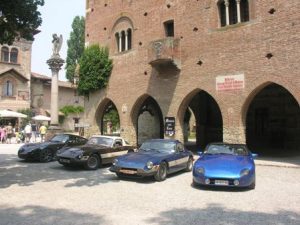
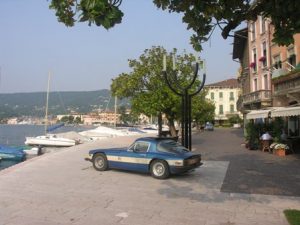
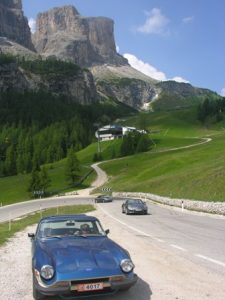
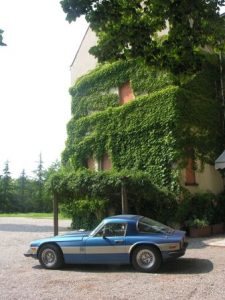
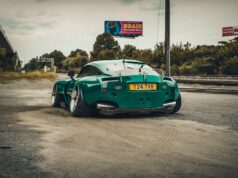
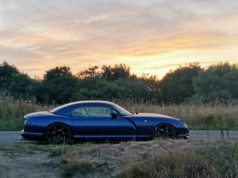
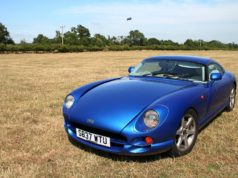
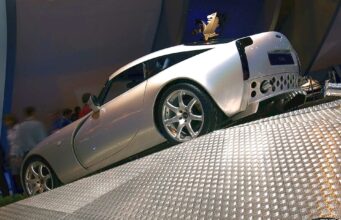

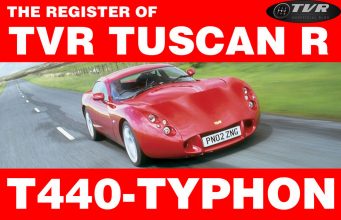









Hi Klifford! These days trip with you have been very nice! Thank you for your words. I hope to see you next time shortly, it would be great!
Maxim :o)